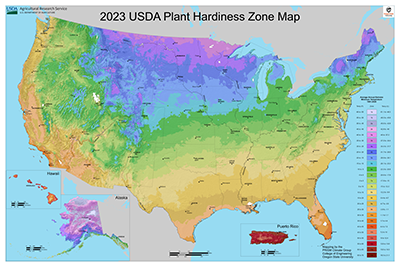Planning Your Landscape to Conserve Water
Water conservation is especially on people’s minds during dry periods, but it’s important all the time. One way you can save water is by selecting plants that suit your site. This principle is called “right plant, right place.” By selecting plants whose needs match the conditions of your landscape, you’ll save yourself money and effort.
Matchmaking
Putting the right plant in the right place involves more than placing a sun-loving plant in a sunny spot or a shade-lover in a shady spot. You also need to consider other site conditions such as soil pH and plant needs such as water.
Drought-tolerant Plants

These plants are adapted to regions with frequent drought, or to soils with low water-holding capacity. Once established, they can be water-wise additions to a landscape—but not if they’re planted in low-lying areas where water tends to pool. In these conditions, they can quickly succumb to root diseases and other pest problems.
Drought-tolerant plants tend to thrive in elevated dry or windy spots, exposed areas, along unshaded southern and western walls of buildings, and other hot, dry places. Save the low spots, water-adjacent areas, and places with poor drainage for plants that love moist conditions.
Grouping Plants
It’s common to see landscapes with woody plants (trees, shrubs, and certain groundcovers) planted randomly across an expanse of lawn. While this may be normal, it’s not ideal. The truth is that turfgrass and woody ornamentals have different water (and other) needs, so it’s easy to waste water in a landscape like this.
You can conserve water and save money by grouping plants according to their water needs. If you have a zoned irrigation system, you’ll be able to water different areas with different amounts. Limit the number of plants with high water needs, placing them for maximum visual impact.
Turfgrass
For sunny, recreational areas, turfgrass is an excellent choice. But most grass types don’t grow well in dense shade or on steep slopes. Instead of planting grass in these spots, try groundcovers. There are a wide variety of options, many of which can also offer a green carpet look.
Overplanting
A newly planted landscape often looks somewhat sparser than anticipated. Be patient—plants are usually planted when they’re young and smaller than their ultimate full-grown size. It’s a common but costly mistake to overplant the landscape to make it seem fuller right away. The problem is that when plants mature, they’ll be too close together, and will end up competing for water and sunlight. The landscape will look overcrowded, and frequent pruning will be required. Make sure you know the mature size of the plants you purchase, and give them the space they need.
Fast-growing plants may sound appealing, but these kinds of plants require frequent pruning and usually more water than slower-growing plants. Slow-growing plants may take longer to fill in your landscape, but they can ultimately be less work.

Know Your Zone
How well your plants perform depends in large part on your choosing the right plant for your climate and location. On its Plant Hardiness Zone Map, the U.S. Department of Agriculture has designated ten climate zones for the continental U.S. to guide us in our gardening efforts. The three zones in Florida are numbers eight through ten. Taking into account which zone you live in can make all the difference.
Weeds and Fertilizer
Both weeds and fertilizer add to water needs in your landscape—weeds because they drink up water your plants would otherwise get, and fertilizer because it causes your plants to grow more quickly, which can lead to a greater need for water.
Fertilize only when necessary. In very dry times hold off of fertilizing your lawn and landscape plants. Keep your beds weed-free by hand-pulling them and adding 2 to 3 inches of mulch, which also helps soil retain moisture.
It’s never too late to save water. Try these methods today!
Sources
G. Knox, Landscape Design for Water Conservation (ENH72), Environmental Horticulture Department (rev. 10/2003).
Right Plant, Right Place—Florida Yards & Neighborhoods
